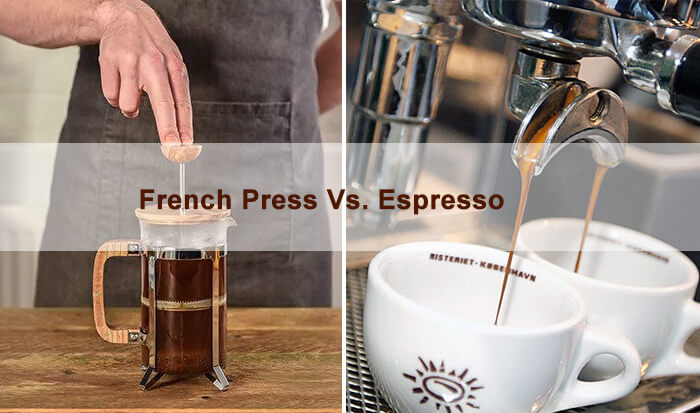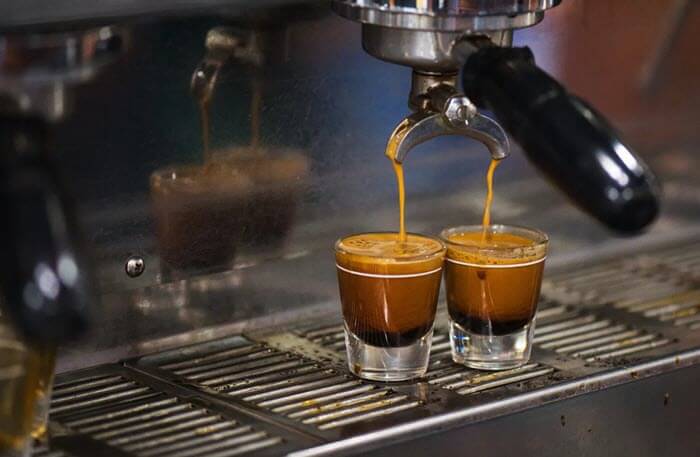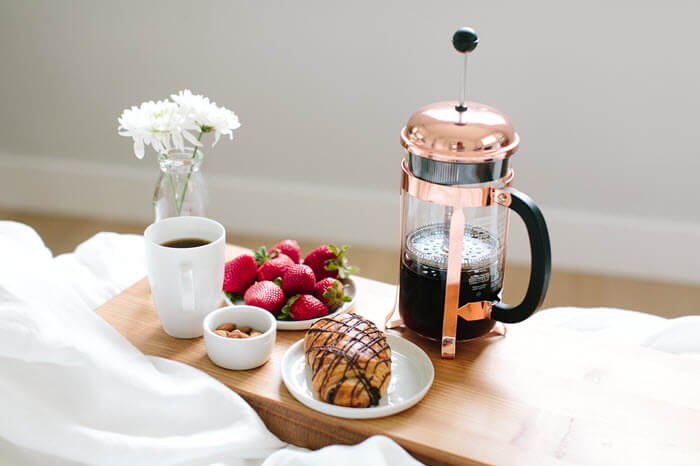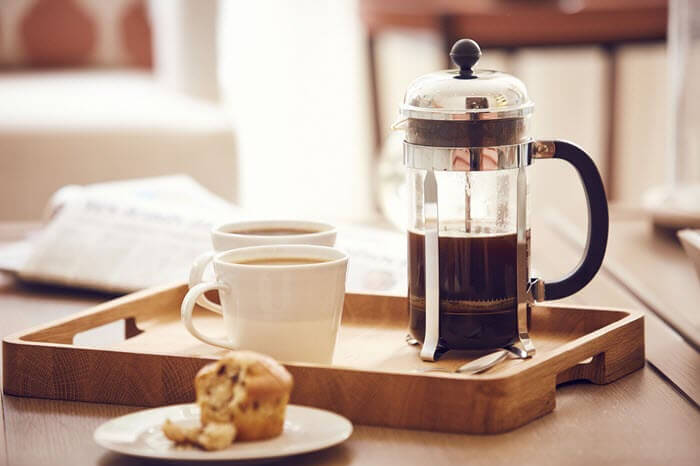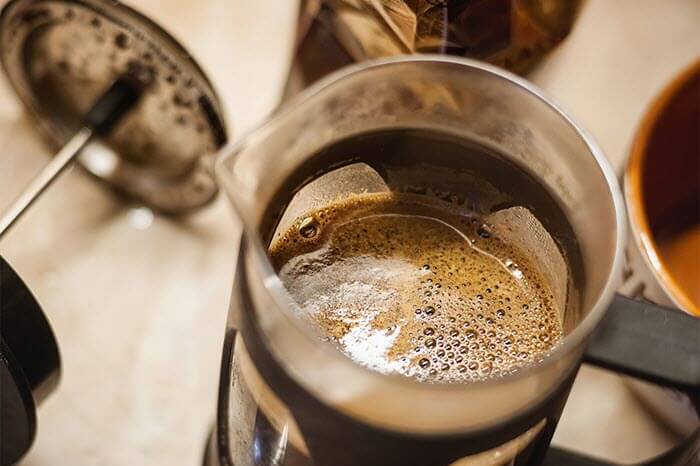We think coffee is one of the best gifts the universe has given us.
Every coffee lover feels the same way; most importantly, we have different coffee types, variety they say is the essence of life.
This article will discuss two brewed coffee types, namely French press vs. Espresso. We’ll discuss their differences and answer any questions you might have.
To begin, let’s make the introductions.
Table Of Contents
- 15-Second Summary
- French Press Vs. Espresso -What Are They?
- Differences Between French Press Coffee and Espresso
- 1. Process- Dynamics is the rule, french press coffee wins.
- 2. Coffee Roast Versatility- French coffee accepts all.
- 3. Flavor- French press coffee gives you 100% flavor.
- 4. Budget- French press helps you secure “the bag.”
- 5. Caffeine- Espresso has less caffeine
- 6. Health- French press might be bad for you.
- FAQs About French Press Vs. Espresso
15-Second Summary
- French press coffee and Espresso are made from different brewing processes.
- French press coffee is prepared by steeping coffee in hot water for a long time. Espresso has a quick brew contact between coffee grounds and water.
French Press Vs. Espresso -What Are They?
What is French Press
The French press is a coffee brewing machine. Also called the coffee press machine that was invented in the late 1920s.
- The first process in brewing your french coffee is steeping. Pour the coffee grounds and hot water into the beaker.
- In the second process, press the metal mesh filter on the beaker (piston) to separate the coffee grounds from the liquid coffee.
- After this, what you have is your favorite french press coffee.
This entire process prevents your coffee from having that characteristic bitter taste.
Bonus: Best Electric/Manual Coffee Grinders for French Press
What is Espresso Coffee
The Espresso is a strong black coffee that forces steam through ground coffee beans.
It’s made from an expensive fancy brewing Espresso machine used in most coffee shops to brew espresso coffee.
At this point, let’s find out what other differences exist between these coffee types.
Bonus: if you’re looking for the best Espresso powder for drinking, check out our latest research here.
Differences Between French Press Coffee and Espresso
If you consider how you like your coffee, the differences in these coffee types might be perks for you. So here is a list of differences.
1. Process- Dynamics is the rule, french press coffee wins.
We do not want to sound “biased” towards french press coffee. However, the French press wins when it comes to the process; why?
Process of Frech Press Coffee
If you would like to prepare a french press coffee, it’s more hands-on; you can’t turn on the machine and allow it to do the rest.
You stay there, determine the steeping time, water to coffee ground ratio, how hard to push the plunger, etc. You can play around with the process.
Process of Espresso
But Espresso is more “static” and automated. The machine works differently, so the coffee you get is pretty much the same.
You can adjust the number of coffee grounds you use and maybe decide to allow the water to run or turn it off. But of course, the coffee comes out pretty much the same.
Some people might say, “well, the espresso brewing process makes it easy for me to do other things while waiting for my coffee.”
We completely understand that, and we recommend that for people who like their coffee, well “express.”
2. Coffee Roast Versatility- French coffee accepts all.
Some bean roasts are delicate; they might require you to handle them gently, so they don’t get scalded.
Arabica beans are delicate coffee beans roasts. When you use them to prepare french press coffee, it gives flavor and aroma without scalding the beans.
But with Espresso, you risk scalding your coffee roast, plus you get less flavor since the water is in contact with the bean for a short time.
So what kind of coffee can you use for the french press?
Its preparation can work with both light and more robust coffee bean blends with the French press coffee. So whether it’s Arabica or Robusta, it works with french coffee.
Unlike Espresso, the Robusta might be a better fit.
3. Flavor- French press coffee gives you 100% flavor.
Different coffee roasts have different flavors. However, depending on how you brew, the resulting coffee might be a burst of flavors.
Flavor of French Press Coffee
French coffee is brewed by steeping, so you determine the temperature of your water and use it as desired.
The steeping gradually extracts the flavor and taste of the coffee. You can be confident the flavor game is at 100% for any bean type you use.
Flavor of French Press Coffee
However, espresso brewing requires the coffee grounds to contact the water for little time, so what you get is a fast coffee but less flavor.
For French press vs. Espresso, the coffee of the former is usually dark, more robust, and flavored.
With Espresso, the coffee is good but not as flavored. The espresso coffee is intense and strong as its brewing methods push out the flavor and serves them to you on the highest notes.
4. Budget- French press helps you secure “the bag.”
French Press coffee helps you save costs. It is your best option if you are on a budget but still love to enjoy brewing your coffee.
Espresso machines are more expensive and fancy; the high-end ones have advanced technology. So to prepare your Espresso might require that you invest in a suitable machine; even the simplest one is not cheap.
5. Caffeine- Espresso has less caffeine
Caffeine presence or absence might be good or bad, depending on who’s drinking.
When it comes to espresso Vs.french press caffeine, you get more caffeine with the french press than with Espresso.
The reason for that goes back to their brewing methods. Since steeping the coffee bean gradually extracts the goodness of the bean, its caffeine is higher.
6. Health- French press might be bad for you.
Remember that health is wealth before you scream, “it gives me what I want.”
Coffee types can be filtered or unfiltered; unfiltered coffee types come with associated cons. Examples of unfiltered coffee products are French press, Espresso, and Turkish-style coffee.
Filtered coffee is coffee grounds made to pass through a paper filter. Passing through a filter strains out the substances released when you steep coffee grounds. Unfiltered coffee is the opposite, every substance lands in your coffee mug.
Research has shown that unfiltered coffee might inhibit your heart health.
French press coffee contains diterpenes [1]. It’s an oily component of coffee beans that can raise your bad cholesterol (LDL cholesterol). High cholesterol means you have a higher chance of a stroke, heart attack, or other heart-related diseases.
Did you scream, “Oh no! But I love French press coffee?“.
Doctors say that five to eight cups [2] of unfiltered Coffee daily will raise your LDL cholesterol. So reduce your unfiltered coffee intake and watch your cholesterol levels.
So, are french presses bad for you? Yes, they can be; however, moderate consumption and routine checks on your health can prevent a disaster.
We know we’ve explained at length what these coffee types are and the differences. Let’s answer a couple of questions.
FAQs About French Press Vs. Espresso
Can I make Espresso in a French press?
Surprisingly, yes, you can. A French press can make a simple yet delicious cup of Espresso. The best part is you get to skip buying an espresso machine.
Is French press the same as Espresso?
No. They are two different coffee types, brewed differently.
Does French press coffee have more caffeine?
Yes, french press coffee has more caffeine than Espresso. This is because of its brewing method. Be careful of how much you consume daily.
What ratio can I use for my French press vs. Espresso?
To make an espresso, we recommend you use two spoons of coffee for every cup of water. And a 1:12 coffee to water ratio.
How to make Espresso in French press?
It’s pretty easy [3].
- Get your coarse grounds of coffee beans.
- Then boil water.
- Add your coffee grounds to the press, then pour hot water and allow it to bloom for a minute.
- After blooming, add the remaining half of the water and steep for 3minutes.
- Don’t press the plunger during this process.
- Once 3 minutes elapses, press the plunger steadily with even pressure.
- Then raise the plunger halfway and plunge to the end to complete the press.
- After this, serve your espresso coffee.
Final Thoughts
Making a cup of coffee goes beyond just pouring the grounds into the machine. To get the most satisfactory results, especially in french press coffee vs. Espresso, you need to be intentional.
Determine what you want in terms of flavor, brewing method, machine to use, and lots more. Once you have all that, you might enjoy the process. Happy brewing!
Related Post

